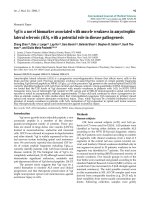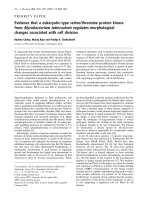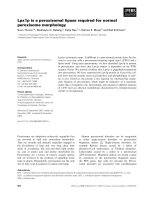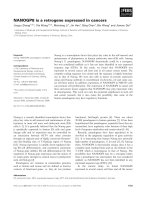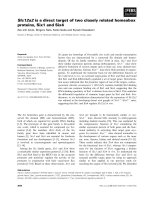Báo cáo y học: "Life is a Ponzi scheme" potx
Bạn đang xem bản rút gọn của tài liệu. Xem và tải ngay bản đầy đủ của tài liệu tại đây (49.65 KB, 4 trang )
Genome
BBiioollooggyy
2009,
1100::
101
Comment
LLiiffee iiss aa PPoonnzzii sscchheemmee
Gregory A Petsko
Address: Rosenstiel Basic Medical Sciences Research Center, Brandeis University, Waltham, MA 02454-9110, USA.
Email:
Published: 27 January 2009
Genome
BBiioollooggyy
2009,
1100::
101 (doi:10.1186/gb-2009-10-1-101)
The electronic version of this article is the complete one and can be
found online at />© 2009 BioMed Central Ltd
Unless you've spent the last month on a spacecraft
returning from Mars, you've probably heard of Bernard
Madoff, the American financier who stands accused of
perpetrating what may be the greatest investment fraud in
history. Estimates of the amount of money lost by investors
in the investment fund managed by Madoff, a former
chairman of the NASDAQ Stock Market, range up to US$50
billion. One of Madoff's biggest investors, René-Thierry
Magon de la Villehuchet, committed suicide on 23
December 2008 following the disclosure of the scheme.
Villehuchet is thought to have lost as much as $1.4 billion in
Madoff's fund. A number of charitable foundations, several
of which provide funding for disease-related biomedical
research, lost huge percentages of their endowments.
Several universities have been significantly harmed as well,
since either some of their own money or the savings of some
of their biggest regular donors turned out to have been
invested with Madoff.
The particular type of con game that Bernard Madoff
practiced is surprisingly simple for someone whose web of
deceit appears to have been so tangled. It's called a Ponzi
scheme. The fraud takes its name from Charles Ponzi, who
was one of the greatest swindlers in history. Born Carlo
Ponzi in 1882 in Parma, Italy, he emigrated to the United
States in 1903. After working at a series of low-paying jobs
for several years, he moved to Montreal in 1907 and became
an assistant in a bank that had been set up to serve the needs
of Italian immigrants to Canada. The bank eventually failed
because of bad real-estate loans - sounds familiar? - but
Ponzi stayed on in Canada where eventually he was jailed for
three years for check forgery. On his release in 1911 he joined
a scheme to smuggle illegal aliens across the border to the
United States, was caught, and served a further two years in
prison, this time in Atlanta, Georgia. There he met Charles
W Morse, a financier who had been convicted of violating
federal banking laws. Morse became a sort of guru to Ponzi,
who began to see the possibilities in white-collar crime. After
his release, Ponzi made his way to Boston, Massachusetts,
where he set up the investment scheme that was to make
him famous - and notorious.
To call his pitch to prospective pigeons attractive would be to
understate the case. He promised clients a 50% profit within
45 days, or 100% profit within 90 days, by buying
discounted postal reply coupons in other countries and
redeeming them at face value in the United States, a form of
what we currently call 'arbitrage' (the practice of taking
advantage of a difference in price between two or more
markets). A simple, and classic, example of arbitrage would
be to collect discarded soda cans in Massachusetts, where
they are sold with a deposit of $0.05 each, and truck them to
Michigan, where the returned deposit is $0.10 per can. (For
those of you thinking of funding your research this way,
forget it: the cost of collecting and transporting the cans
eliminates the profit. However, about $10 million worth of
empty bottles and cans do get smuggled into Michigan from
neighboring Ohio and Indiana, which do not require a
deposit on beverage containers. Returning those out-of-state
bottles and cans in Michigan does make a small profit.
Michigan lawmakers have proposed requiring that beverage
manufacturers put a code on all bottles and cans that are
sold in Michigan, and that automated bottle return machines
be programmed to read the code so they accept only
containers originally sold in Michigan.)
Ponzi wasn't arbitraging soda cans, though. The commodity
he claimed to be buying and selling was international postal
reply coupons. A postal reply coupon is a piece of paper
included in a message sent by someone in one country to a
correspondent in another country, so the recipient can use
the coupon to pay the postage for a reply - the modern
equivalent, within one country, is the stamped, self-
addressed envelope. What made them attractive for
arbitrage is that the coupons were priced at the cost of
postage in the country of purchase, but were exchanged for
stamps to cover the cost of postage in the country where
redeemed; if these values were different, there was a
potential profit. Inflation after the First World War had
reduced the cost of postage in Italy as expressed in US
dollars, so an international postal reply coupon bought in
Rome could, in theory, be exchanged in Boston for stamps
with a much higher dollar value. As explained by Ponzi,
investors would give him money; he would send that money
abroad, where his agents would purchase reply coupons; the
agents would send the coupons to the US, where Ponzi
would redeem them for stamps of a higher value; and he
would then sell the stamps. Ponzi claimed that the net profit
on these perfectly legal transactions, after expenses and
exchange rates, was in excess of 400%.
In the first two months of 1920, some people invested and
were paid large returns (100% profit in a few weeks). Word
spread, and investment came in at an ever-increasing rate.
Ponzi hired agents to drum up new business and paid them
generous commissions for every dollar they brought in. At
that time all investors were being paid impressive rates,
which encouraged others to invest. By May 1920, Ponzi had
made $420,000 (over $4.5 million in 2008 dollars). By
July 1920, he had made millions. People were mortgaging
their homes and investing their life savings in his company.
Most did not take their profits out, but reinvested them,
believing that the enormous returns would continue
forever.
What none of them knew was that Charles Ponzi wasn't
buying and selling postal reply coupons. In fact, he wasn't
arbitraging anything. What he was actually doing was
running what is called a pyramid scheme: as long as money
kept flowing in at a greater rate than people were
withdrawing it, existing investors (the top of the pyramid)
could be paid with a portion of the money brought in from
the larger horde of new investors (the pyramid bottom). By
24 July 1920, the pyramid scheme was returning for Ponzi's
firm, The Securities Exchange Company, the astounding
sum of $250,000 a day.
Well, my father, who was trained as an economist, always said
that if something seems too good to be true, it probably isn't
either good or true. Clarence Barron, the financial analyst who
founded the financial magazine Barron's, started to examine
Ponzi's outrageous returns. Barron first noted that Ponzi
hadn't invested his own money with his own company - always
a red flag. Then he calculated that, to cover the investments
made with the Securities Exchange Company, about
160,000,000 postal reply coupons would have to be in
circulation. However, only about 27,000 coupons were
actually circulating worldwide. He checked with the US Post
Office, who confirmed that postal reply coupons were not
being bought or redeemed in large quantities, either at home
or abroad. Finally, Barron crunched the numbers, and found
the same thing for arbitraging postal reply coupons that you
would find if you tried to redeem Massachusetts soda cans in
Michigan: the gross profit margin in percent on each item was
huge, but the actual return per item was very small, and the
overhead required to handle the purchase and redemption of
the necessarily huge number of items, which were sold
individually, would have far exceeded the gross profit.
The Boston Post published the results of Barron's
investigation, and ran a headline on 2 August 1920,
declaring Ponzi hopelessly insolvent. On 10 August federal
agents raided the Securities Exchange Company and shut it
down. Of course, they found no large stock of postal reply
coupons. On 12 August 1920, Ponzi was arrested. Seventeen
thousand people had invested millions, maybe tens of
millions, with him over a period of less than nine months.
Most lost everything.
After serving years in prison on both federal and state
charges, Charles Ponzi was deported to Italy in 1934. He
died a pauper in a charity hospital in Rio de Janeiro on 18
January 1949.
It now appears that Bernard Madoff was running a similar
pyramid scheme, on a colossal scale. He was cleverer about
it, of course, since he had Ponzi's mistakes to learn from.
Rather than offer suspiciously high returns to all comers,
Madoff instead offered modest, but steady returns (about
10-15% per year). Furthermore, Madoff didn't solicit
business; instead, he deliberately made it difficult to invest.
By catering to an exclusive clientele, one that had to be both
super-rich and selected by him, he drove up the demand for
his services through their scarcity. The scheme also differed
from Ponzi's in that a number of other investment funds
invested much or all of their holdings in Madoff's fund,
which meant that many individual investors, who believed
they were diversified, unknowingly had all their eggs in the
Madoff basket.
There were a number of red flags that should have alerted
both financial analysts and government regulators to the
probably fraudulent nature of Madoff's business (to be fair, a
small number, such as Boston financial specialist Harry
Markopolos, did sound warnings about Madoff for years, but
were ignored). For one, almost identical returns were
produced in both up and down markets - an impossibility
with honest trading. Another red flag is that the investment
method was stated to be a proprietary secret.
The slow pace and 'insider' marketing enabled the scheme
to survive for an unusually long time and also to grow far
larger than would be expected of a common Ponzi scheme.
What caused it to collapse? The general market downturn
of 2008 caused new investments to decrease and forced a
larger than usual number of existing investors to cash out
their positions. That's what usually brings down a pyramid
scheme: when the top of the pyramid demands more
money back than the bottom is putting in ('illiquidity' in
finance-speak).
Genome
BBiioollooggyy
2009, Volume 10, Issue 1, Article 101 Petsko 101.2
Genome
BBiioollooggyy
2009,
1100::
101
Now, the reason you're reading about this here, is that I just
realized that life itself is basically a gigantic Ponzi scheme,
and the pyramid is dangerously close to collapsing. In the
developed world, we have evolved a society in which a
relatively small number of old people have many of their
needs cared for through the financial contributions of a
larger number of much younger people. And that made
sense, because for over 12,000 years the age distribution of
the human population was, in fact, in the shape of a
pyramid, with a huge base of young children rising to a
smaller number of teenagers and a still smaller number of
young adults, and so on up to a tiny tip of the elderly. But
sometime in the 1950s, as the birthrate declined and life
expectancy continued to increase, the pyramid started to be
shaped more like a column. Within the next 40 years it will
become one, and then it will slowly invert.
Worldwide, the average life expectancy at birth in 1955 was
just 48 years; in 1995 it was 65 years; in 2025 it will reach
73 years. By the year 2025, it is expected that no country
on Earth will have a life expectancy of less than 50 years.
That has never happened before in human history.
Globally, the population of children under 5 will grow by
just 0.25% annually between 1995-2025, while the
population over 65 years will grow by 2.6%. The average
number of babies per woman of child-bearing age was 5.0
in 1955, falling to 2.9 in 1995; it will reach 2.3 in 2025.
While only 3 countries were below the population
replacement level of 2.1 babies in 1955, there will be 102
such countries by 2025. The World Health Organization
has estimated that the proportion of older people requiring
support from adults of working age will increase globally
from 10.5% in 1955 and 12.3% in 1995 to 17.2% in 2025. In
1955, there were 12 people aged over 65 for every 100 aged
under 20. By 1995, the old/young ratio was 16/100; by
2025 it will be 31/100. By the end of the century it will
approach unity. Eventually - and eventually isn't that far
off - we will live in world where a smaller number of young
people will be asked to support a larger number of the very
old. No Ponzi scheme can survive that.
Consider healthcare. Total healthcare costs in the United
States now exceed $1 trillion, 14% of the gross domestic
product. Of this total, a disproportionate share is spent on
the care of elderly patients shortly before their deaths. Most
elderly people have the bulk of their medical care paid for by
Medicare, a state-supported program. Workers pay into it
during their years of peak employment, and as retirees they
then draw down from it as they age. However, the 5% of
Medicare recipients 65 years of age and older who die in any
one year account for around 30% of all costs of the Medicare
program. Seventy-seven percent of the Medicare decedents'
total healthcare expenditures occur in their last year of life, a
staggering 52% in the last 2 months, and 40% in the last
month. We are basically spending a fortune as a society for
healthcare for very old, very sick people that does not
increase the lifespan of the individual by more than 30 days,
if at all.
We could, of course, handle this cost imbalance by draconian
decisions about life and death, but that is probably a political
(and maybe ethical) non-starter (although don't be surprised
if it doesn't become part of the conversation if we don't find
other ways to control costs). And the population pyramid
would change dramatically if we had a global thermonuclear
war or a planet-wide plague, but we probably won't be so
lucky. And science may actually be on its way to making the
problem worse.
There are a number of genomics-driven research programs,
some based on model organisms but others involving
mammals right up to people, that aim to increase the
human lifespan. If successful, they would spell the rapid
and certain ruin of the Ponzi-like social contract between
old and young, by guaranteeing a completely inverted
population pyramid. I believe that it is pointless to increase
the human lifespan unless the quality of life for the elderly
is also increased. Specifically, this means that we must
greatly improve the health of our oldest citizens unless we
wish to see our economy collapse, soon, from the burden of
caring for them.
That's going to be a tall order, because age is a major risk
factor for just about everything bad that can happen to a
human being. Incidence of neurodegenerative diseases such
as Alzheimer's and Parkinson's diseases rises exponentially
with age after 65, until people over 80 have almost one
chance in two of suffering from one of them. Half of all
cancer deaths occur in people over 75 years of age. The
greatest risk factor for prostate cancer is age: more than 75%
of all prostate cancers are diagnosed in men over 65. Over
80% of deaths from circulatory disease occur in people over
65. Stroke, the third leading cause of death in the United
States (after heart disease and all forms of cancer), is 30
times more likely in men over 90 than it is in those aged 55-
59. When you add in bone density loss, arthritis, and other
age-related disorders, it's hard not to agree with the Rolling
Stones' lyric from the song Mother's Little Helper: "What a
drag it is, getting old."
Controlling healthcare costs and making sure that everyone
can afford basic care, though essential, is not going to be
enough in the long run - not with that demographic time-
bomb ticking away in the background. Our only hope as a
species lies with biomedical research. And that research
needs to be aimed at prevention, not just treatment, because
it's always more expensive to treat an illness than it is to
prevent it. Oddly, we tend to be more easily alarmed by the
relatively improbable prospect of epidemics such as avian flu
than we are by a certain likelihood that most of us will, if we
live long enough, fall prey to devastating chronic ailments.
As a result, we invest much more money in planning for and
Genome
BBiioollooggyy
2009 Volume 10, Issue 1, Article 101 Petsko 101.3
Genome
BBiioollooggyy
2009,
1100::
101
warding off the former than we do in dealing with the latter.
This mindset has to change.
The line of succession from Charles Ponzi to Bernard Madoff
is more than a chronicle of cupidity. It's a microcosm of the
way we've organized our society. For thousands of years it
made sense to assume that there would always be more
young people to pay for the care of older ones. But Ponzi and
Madoff failed because they forgot that no pyramid lasts
forever. We had better remember that.
Genome
BBiioollooggyy
2009, Volume 10, Issue 1, Article 101 Petsko 101.4
Genome
BBiioollooggyy
2009,
1100::
101
